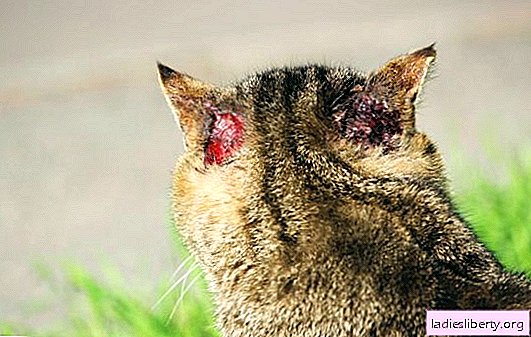
Any health problems in our pets bring a lot of worries and worries. Skin diseases are quite difficult to treat, so the owners need to pay a lot of attention and be patient, and it also takes a lot of time. Demodecosis in cats is one of the most difficult diseases to treat.
What kind of disease?
Demodecosis (also called a subcutaneous tick) is a disease in which damage to the skin and coat of an animal occurs, caused by ticks Demodex cati and Demodex gatoi. These mites parasitize on the skin of a pet, affecting its coat.
People also suffer from demodicosis, but the feline form is safe for their owners and they cannot be infected from their pets, since cats and people suffer from different forms of demodicosis, other types of parasites cause it in people.
There are two types of disease: localized and generalized.
The localized form affects only one part of the body and does not appear on the legs. The generalized form affects most of the animal’s body and appears on the legs. This type is more difficult to tolerate and treat, because the disease can affect the internal organs. Doctors advise castrating / sterilizing the animal when a disease is detected, as future offspring will be carriers of the disease.
Causes of infection and diagnosis of demodicosis in cats
Demodecosis can affect cats regardless of breed and at any age. It is transmitted genetically, if the mother was infected, then the offspring can be born already as carriers of the tick. Also, the disease is transmitted by contact with already infected cats.
The main symptoms of demodicosis in cats are:
1) itching, redness on the skin, a change in its pigmentation; sometimes rashes in the form of nodules or acne may appear
2) the coat becomes less well-groomed, the deterioration of the quality of the coat
3) bleeding small wounds
4) "demodectic glasses" - a worsening of the condition around the eyes, bald spots in the coat and peeling of open areas
5) on the head and ears a poor condition of the coat and skin, with a generalized form is observed on the legs
6) a general deterioration in the well-being of the pet, a decrease in appetite and activity. With a generalized form, it can also affect the work of internal organs, which can greatly affect the health of the pet.
The faster you take the pet to the specialist, the easier the treatment will be!
To establish an accurate diagnosis, you must contact the veterinary clinic, where the necessary tests will be performed. Doctors will take a scraping from the skin (at least 4-5 samples), the analysis will help rule out other similar skin diseases.
Treatment of demodicosis in a cat
Do not try to cure the animal at home without an accurate diagnosis and medication prescribed by your doctor! Such medicines are toxic, any violation of the instructions can seriously harm the cat!
The treatment is quite difficult and takes a long period of time - up to one year. The main points are as follows:
1) In localized form, special shampoos with benzoyl peroxide or chlorhexidine are used. This is necessary in order to remove dead and dried skin pieces, after which be sure to dry the skin.
2) Those places where the symptoms are already visible - there is no hair and the skin is peeling, it is necessary to regularly treat with a solution of chlorhexidine or hydrogen peroxide, after which they are treated with drugs in the form of ointments or gels. Usually, Amitraz, Tsiteal, Butoks 50 solutions and Amidel gel ointments, Ivermek gel, Aversectin ointment are prescribed. Be sure to check with your doctor what exactly you need.
Sometimes doctors may recommend special oil solutions for treatment: Mycodemocide, Tsipam, Ektodes, Amit. Use them strictly according to the instructions and do not violate the dosage!
3) It is important to choose immunostimulating drugs and vitamins to help the body resist the development of the disease. Be sure to use a combination of: maxidine, gamavit, gala-vet, immunol to strengthen immunity and all sprays and ointments that the doctor will prescribe.
4) In the form of injections, antiparasitic drugs are prescribed, such as ivermectin, amirtrazine, baymek, newmek.
5) Be sure to completely replace or disinfect all cat accessories - this is a bowl, tray, toys, scratching post and combs, as well as a house and carrying. Better to replace right away than to re-treat the animal.
In the generalized form, the same preparations are used as in the localized form. Usually only antibiotics are added to them, such as Kanamycin, Betamox, Baytril, Amoxicillin.
It is important to remember that treatment must not be interrupted until the animal is fully restored! Unfortunately, the disease can "hide" and then the next outbreak can significantly worsen the condition of the cat. Keep an eye on the animal and be sure to take a second test with your doctor, this is necessary to check whether you were able to fully recover and whether everything will return back after a month.
Alternative methods for the treatment of demodicosis in cats
Use them with caution. You can not completely replace medication with folk methods, this is fraught with problems for the health and life of the animal! Be sure to consult with your doctor whether the following tools should be used as additional methods:
1) chamomile solution - can be applied pointwise or bathed in it entirely once every two to three days
2) tincture of calendula - it is possible to treat parts of the body affected by the disease
3) kerosene - applied to the affected areas, can not be washed off for two days
Cat Demodecosis Prevention
In order not to face the problem of demodicosis in cats or to facilitate treatment, preventive measures are necessary. The most important thing is to maintain your pet’s immunity in good condition and to conduct all vaccinations in a timely manner. Take care what kind of food your cat has and where she walks, do not forget to give her all the useful vitamins and minerals. Try to protect your pet from possible sources of infection, often inspect your pet and especially his ears.
Particular attention should be paid to the treatment of skin from fleas and ticks.
If you are the owner of several pets, then if you find a disease in one of them, immediately isolate it and completely change all accessories - bowls, tray, toys and stove benches. Carefully monitor the rest to detect the disease from the very beginning and give everyone vitamins to strengthen immunity.











